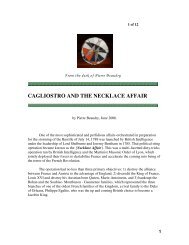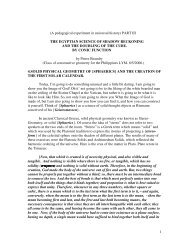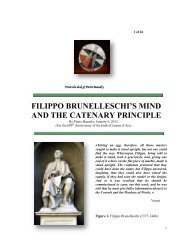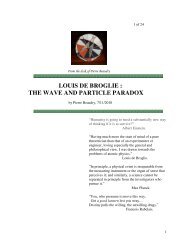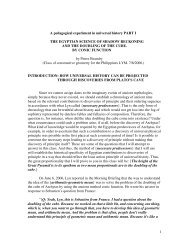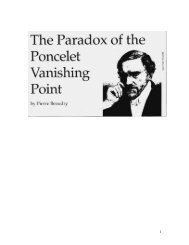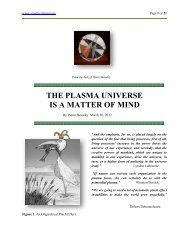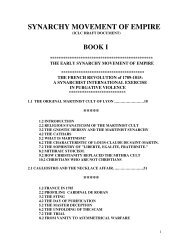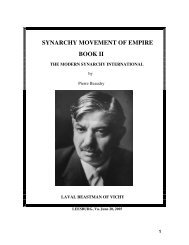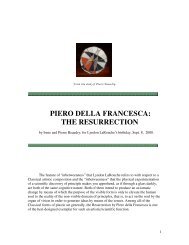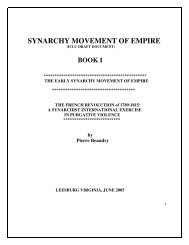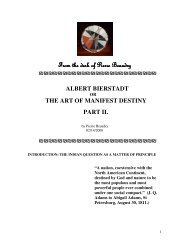BEETHOVEN SONATA OPUS 27, NO. 2.pdf - Pierre Beaudry's ...
BEETHOVEN SONATA OPUS 27, NO. 2.pdf - Pierre Beaudry's ...
BEETHOVEN SONATA OPUS 27, NO. 2.pdf - Pierre Beaudry's ...
You also want an ePaper? Increase the reach of your titles
YUMPU automatically turns print PDFs into web optimized ePapers that Google loves.
“The Lydian interval is the only interval which cannot be generated by the principle of inversion<br />
of complementary intervals within any given key. This interval uniquely divides the octave exactly in<br />
half: that is, the interval from the tonic to the Lydian tone is the same amount of change as the interval<br />
from the Lydian tone to the octave. In the key of C major/minor, for example, this corresponds to the<br />
interval between C and F♯, which also corresponds to the physical singularity of the register breaks in<br />
the soprano and tenor singing voice [Figure 5(a)]. (above)<br />
“Divide an octave in half. This generates a Lydian interval. In the major/minor mode, the Lydian<br />
interval is a dissonance with respect to any given key. For example, in the key of C major/minor, the<br />
interval C-F♯ is such a dissonance. Yet this Lydian interval has the unique property of being a pathway<br />
from one key to the next, by way of the leading tone of that next key (F♯-G in the key of<br />
G major/G minor) [Figure 5(b)]. It is a type of singularity to be resolved through the development of the<br />
composition.<br />
“When the octave is divided in half again, two Lydian intervals are created. There are only three<br />
such combinations possible in the well-tempered system [Figure 5(c)]. (above)” (Bruce Director, What<br />
Mathematics Can Learn from Classical Music, Fidelio Magazine, Winter 1994.)<br />
3. THE GOVERNING MORAL PRINCIPLE OF MUSIC<br />
As Beethoven wrote to his dearest friend Carl Amanda on July 1, 1801: “A sad resignation must<br />
be my refuge, although, indeed, I am resolved to rise above every obstacle.” (Beethoven letter to Amanda,<br />
July 1, 1801 in Op. Cit, p. 282.) This, without a doubt, was the time when Beethoven had no choice but to<br />
settle his account with the domain of sense perception and consecrate the rest of his life to the domain of<br />
musical ideas. It was not an easy decision to make. As his so-called Heiligenstadt Testament of 1802,<br />
attests, the year when he composed this sonata was THE turning point in his life, because he knew he was<br />
becoming completely deaf. Again, the singularity, better still the paradox, was the absolute tension<br />
between something that was inevitable and the relentless urge to obey his destiny. As he wrote in his<br />
testament:<br />
“But, what a humiliation for me when someone standing next to me heard a flute in the<br />
distance and I heard nothing, or someone heard a shepherd singing and again, I heard nothing.<br />
Such incidents drove me almost to despair, a little more of that and I would have ended my life –<br />
it was only my art that held me back. Ah, it seemed to me impossible to leave the world until I<br />
had brought forth all that I felt was within me. So, I endured this wretched existence”… “Divine<br />
One, thou seest my inmost soul, thou knowest that therein dwells the love of mankind and the<br />
desire to do good. – Oh fellow men, when at some point you read this, consider that you have<br />
done me an injustice; someone who has had misfortune may console himself to find a similar case<br />
10




